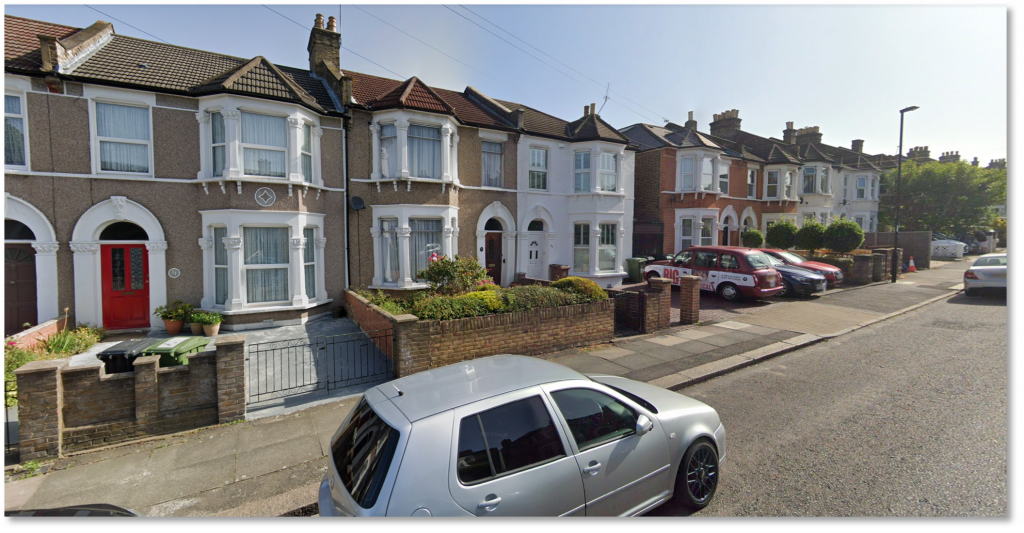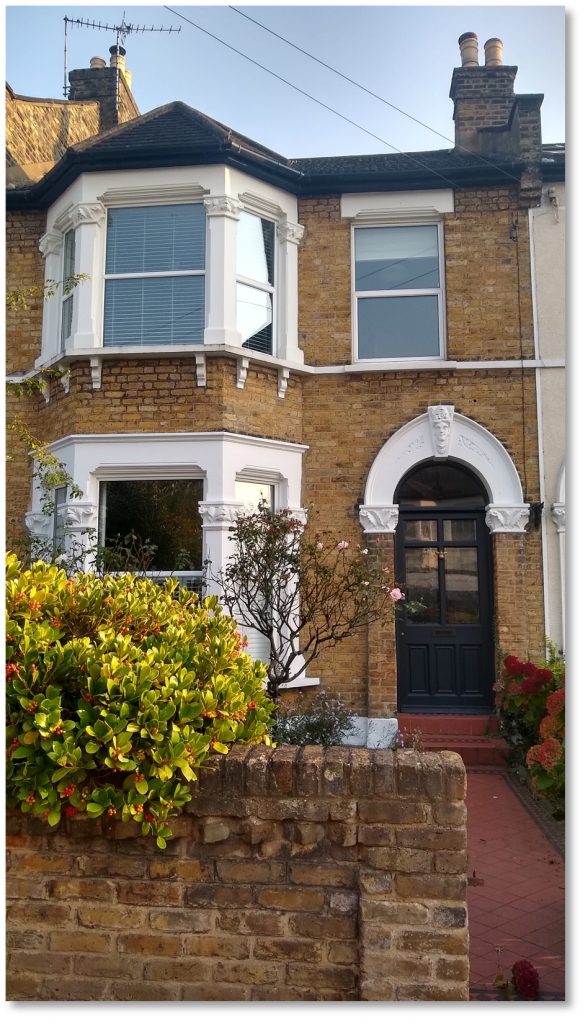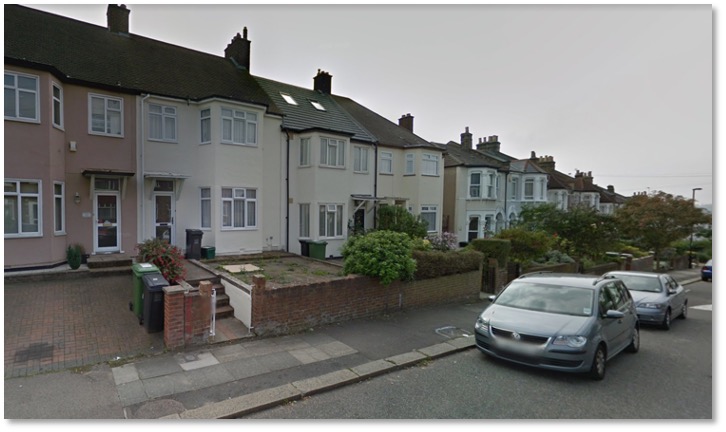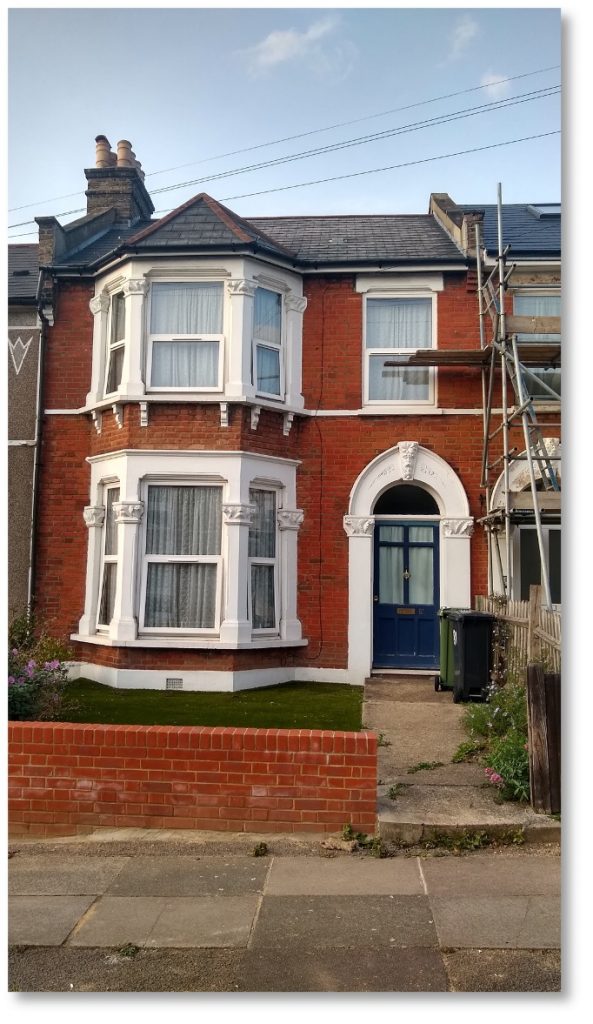“Home to memoir writer Harry Lyle Sutton”

A view of the north side of Arngask Road near the bottom of the street
Background
The name ‘Arngask’ comes from Scotland, as do nearly all of the Corbett Estate street names. It refers to a parish in Perthshire, and Archibald chose it because of its links to his younger brother Harry, who had died in his late 20’s of tuberculosis. Harry had bequeathed his collection of books to the main village in the area – Glenfarg, and a library was erected there in 1892 in his memory. Glenfarg itself, and the nearby hamlet of Duncrievie are also remembered in nearby street names.
The Early Residents: details from the 1911 Census
The 1911 census lists 121 houses in Arngask Road, with 528 occupants (including 11 visitors). As you go up the hill from St Fillans Road, many of the houses on the left have four bedrooms, with a ‘rear extension’ containing the kitchen and the 4th bedroom above it. The houses on the right are slightly larger but lack the rear extension and only have three bedrooms.
The average number of people in each house was 4.3, which is pretty much average for the Estate, but some families were a lot larger of course. If you’d called in at No. 68 you’d have met the Baxters: mother and father Charlotte and Alfred, plus their seven daughters and two sons! Living in the 3-bedroom house must have been quite a tight squeeze for the 11 of them…

No. 68 Arngask Road, home of the Baxter family in 1911
As with almost every other road on the Estate, the top adult male and female names were William and Mary (19 people each); and the equivalent for children were Dorothy and William.
Of those employed (214 of the 517 residents) the most common job was as a Clerk of some kind. 56 people were clerks, including three of the Baxter girls – Mary, Dorothy and Phyllis – as well as their father Alfred. At 26% of the Arngask workforce, the proportion of clerks was higher than the estate-wide average of 20%, which suggests the street was pretty comfortably off: clerks generally earned a decent steady income with the prospect of advancement.
Five households had live-in servants (plus a couple of ‘ladies companions’ which may have been similar to servant). At No. 75 for instance, 15-year-old Gertrude Whale from Bermondsey was a servant to Frank and Sarah Moore and their son Stanley.
The street’s oldest resident was retired gardener William Appleby, aged 82, who lived at No. 29. This was another busy household, with William’s daughter Emily as the (widowed) Head of Household, plus her two daughters and one son, and lodgers Sarah and Thomas Gray.
Bomb damage during World War Two
Arngask was badly damaged by a V1 rocket during the Second World War. Altogether the Estate was hit by six of the German flying bombs: five V1s and one V2. We don’t know what the human cost was on Arngask, but 15 houses on the north side and 13 on the south side near the junction with Torridon Road were destroyed and rebuilt after the war ended. Numerous other houses were damaged by general bombing too.

Newer houses replaced those destroyed by a V1 rocket near the top of Arngask Road
Harry Sutton’s Arngask Memoir
We’re very lucky to have a first-hand account of life in the street in the early 1900s, from one of its very first residents. Harry Sutton was 16 when the census was taken, and he lived at No. 81 with his mother Mary and father Samuel, plus sister Rhoda and Joseph ‘Uncle Tarry’ Tarryer, a long-term lodger.

No. 81 Arngask Road, home to Harry Sutton in 1911
Here’s Harry describing the house, and giving a flavour of life on the Corbett Estate:
“Just before the turn of the century my father bought 81 Arngask Road on the new Corbett estate in Hither Green… [It] stood on a plot 22ft by 100ft, with an open fence garden at the rear, and cost my father when built £285 on a 999 year lease. This was an area of Lewisham of solid London clay, and current opinion prophesied that the houses would all collapse after a few years.
In fact they survived two World Wars, and are still defiantly resisting the march of time. No. 81 was a four-bedroomed house, with dining and drawing rooms, kitchen and, of course, the inevitable Victorian scullery to house the shallow earthenware sink, the monstrous cast-iron gas cooker and the very essential coal heated copper for the boiling of clothes on washing day and of puddings at Christmas. The house was L-shaped, and my sister had the roomy bedroom at the rear over the kitchen and scullery. The bathroom and toilet were just off the head of the stairs, where one then mounted two further steps to the other bedrooms. My parents had the front bedroom over the dining room, and I had the small single room alongside over the hallway. ‘Uncle’ Tarry had the rear bedroom over the drawing room, because it was then that he became a member of the Sutton household. [No 81]
The Hither Green estate built by Mr Corbett was laid out mainly in long straight lines except where landscape irregularities dictated divergences from this pattern. The roadways were wide, bordered by asphalt paths with granite kerbs, and the garden fronts of the houses planted with lime trees. All the houses were terraced, usually in blocks of six, so that the end house of every block had a sideway entrance. Number 83 Arngask was one such end house, occupied by Cornish Mr and Mrs Roach and their eventual family of boys.
Each road differed from another only in the size of its houses, the extent and nature of its appointments, and therefore in the social standing of its residents. The upper stretches of Brownhill and Wellmeadow Roads, with their triple-fronted, bay-windowed, servant-serviced, six bedroomed houses stood highest in the social order. But in these privileged roads there were less distinguished residences, such as the double-fronted five bedroom houses opposite 159 Wellmeadow. In Arngask Road houses were also categorised.
Number 81 had two reception and four bedrooms, plus a kitchen and scullery. But the houses opposite were slightly smaller, with one less bedroom and only a kitchenette. Parallel roads diminished in status as house sizes became smaller and gardens shorter, while bay windows slipped down to ground floor level only or disappeared altogether as in Sangley Road. But they were all well built houses, each with its bathroom.
During the day all the tradespeople called, the milkman first in his chariot style vehicle with its large shining brass churn. From this he filled the oval pewter container inside which hung a half-pint pewter measure with which to ladle the required amounts into the household jugs. He repeated his call in the afternoon, and whatever the retailing of milk may have lacked in hygiene it certainly made up for in frequency. Mr Gosling, the grocer, and Mr Erridge, the butcher, arrived soon after breakfast for the day’s order, which would be made up and delivered later, by the grocer’s boy with a box tricycle, but by the butcher’s assistant on a fast trotting cabriolet-style vehicle much hated by elderly ladies for its dangerous speed. Cracknell the greengrocer called three times a week, carrying to the door a display basket set out with their seasonal produce. Cracknell had a large two-horse van, hung about at the tailboard with dangling baskets of potatoes and other earthy produce, leaving the van interior for the more delicate wares. Atfield the oilman called once a week, and if my mother faltered in her requirements, he would jog her memory with ‘Soap, soda, starch or matches?’ You could smell his van from far off because of the large drum of paraffin alongside an equally large container of vinegar, a characteristic mingling of odours I can still conjure up. The baker was also a morning caller each day, and once a week Carwardine the flour merchant arrived with baking materials. A host of itinerant vendors patrolled the streets; the coalman crying ‘Any coal today?’ the black-faced sweep with a long drawn-out ‘Sw-e-e-ep!’, the rag-and-bone man calling ‘Any old iron?’, and the watercress sellers announcing ‘Fresh cress!’ “
William Rutter, Lamplighter
Another person Harry remembers from Arngask road was the man who used to light the gas streetlamps every evening: it may have been William Rutter, a 34-year-old Lamplighter who lived at No. 70.
“At dusk each day the lamplighter walked diagonally up or down every road to turn on and light up a similar Bray gas jet enclosed in the glazed lantern topping each lamp-post. He carried a long pole, and the lighting-up process was a highly dexterous performance, especially in windy weather. It involved inserting a ‘strike-anywhere’ match in the tip of his pole, turning on the gas tap underneath the base of the lantern, quickly igniting the match by a deft flick against the iron post, and slipping the burning match through a small hole in the lantern base. By then the lantern was usually half full of gas and there was a satisfying miniature explosion from every lamp-post as he criss-crossed down the road.”
At the time, there were tens of thousands of gas lamps across London and the streets of many other British cities. They first came to public attention in 1807 when the new technology was demonstrated in Pall Mall. Apparently each of the lights was fed with gas pipes made from the barrels of old musket guns and applying a single spark lit up the whole street.
By the 1880s their dominance was being threatened by new electric lighting, which took a while to reach the Corbett Estate, but eventually became the primary source of illumination for our streets.
Amazingly however, there are still over a thousand gas lights in use in London today, tended by five British Gas engineers. Kensington Palace Gardens for example is lit only by gas lamps.

An old-style Lamplighter goes about his business
© Daily Mirror/Mirrorpix/Mirrorpix via Getty Images